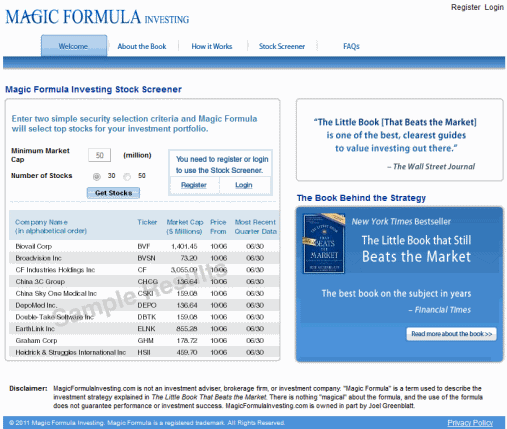"Best Books on Investing"
The Little Book that Still Beats the Market
Joel Greenblatt

Joel Greenblatt’s book makes our list of best books on investing because of the extraordinary content and readability. Commonly known for its development of the Magic Formula investment strategy, the book is actually a must read for everyone interested in developing their own strategies. There is no better primer for multi-factor ranking systems.
In the author’s own words, the basis for the book is found in the intro to the original edition:
After more than 30 years of investing professionally and after 14 years of teaching at an Ivy League business school, I am convinced of at least two things:
- If you really want to "beat the market," most professionals and academics can't help you, and
- That leaves only one real alternative: You must do it yourself.
Joel Greenblatt
There are three basic sections to the book
What is a business worth – Valuation
Buying stock in a company is buying the company. Like any purchase, we don’t want to overpay.
The book describes how to buy stock in a company at a bargain price. Greenblatt begins with Ben Graham’s “Margin of Safety” approach to detail why buying stock below the market price makes sense and then extends this into the approach he recommends.
If you have a valuation factor you prefer to earnings yield, the approach can be broadly applied to other value factors. The good news is that a variety of valuation factors are in both free and fee-based stock screeners.
Identifying good companies – Quality
Based on his extensive investment experience, Greenblatt recommends using Return on Capital as a measure of company quality rather than the more familiar Return on Assets or Return on Equity.
This was my first exposure to Return on Capital – subsequent reading confirmed it is a very powerful metric for identifying quality companies and is commonly used by professionals like Greenblatt. This factor (or a variation of it) is becoming more common in screening tools.
Multi factor ranking – the Magic Formula
Prior to reading The Little Book that Beats the Market and prior to using more advanced screening products, I simply followed the advice of earlier books on investing and ranked the companies passing the screen by what I felt was the most dominant factor in the screen. Or worse (for me), I tried my hand at analyzing the financial results of the passing companies to select the best one.
The idea of using more than one factor in a ranking system may not be a revelation now, but it is critical to understand the underlying concept. This is the book on investing that explains the approach and the supporting rationale.
The Magic Formula – the two factor ranking system - is the tool that identifies good companies at below market prices. More info on the ranking system.
Magic Formula Screener
Many stock screeners offer a screen based on Greenblatt's Magic Formula. So does Greenblatt.
A proprietary screener dedicated to the Magic Formula as described in the book is available. If you want to try it, you will get to the home page shown below. It is free and only registration is required. Check it out.

Other Highlights
Considerable time is spent explaining that even the best
strategies will sometimes under-perform. Extensive back-testing data
generated from the Magic Formula is used.
Another valuable discussion identifies the skill set and/or expertise required for sound qualitative analysis of company fundamentals. And why most of us should stick to quantitative techniques like the Magic Formula.
As a primer, this is the best book on investing available on quantitative multi-factor ranking systems. Both the original edition and the newer edition have the same content. Neither is expensive. Buy either version.
Greenblatt, Joel. The Little Book That Still Beats the Market (John Wiley & Sons, Inc., 2010).
About the author of The Little Book that Still Beats the Market.
Joel Greenblatt is the founder of Gotham Capital and an adjunct faculty professor at Columbia Business School.
HOME | Site Policies | Contact Us | About Me | About Site | Site Map
Popular Pages
CANSLIM Strategy
Folio Investing
Economic Indicators
Portfolio123
Ranking Systems
New
We value your suggestions, comments, and questions.
Our goal is to make this site as useful as possible.
Contact Us
Thanks!
Stock screening tools and consistent, sustainable investing processes.
About Me
Why build a website instead of a blog?
About this site
Updated Jan 2017